
Warren County is a county located in the southwestern part of the U.S. state of Ohio. As of the 2020 census, the population was 242,337. Its county seat is Lebanon and largest city is Mason. The county is one of Ohio's most affluent, with the highest median income of the state's 88 counties. The county was established on May 1, 1803, from Hamilton County; it is named for Dr. Joseph Warren, a hero of the Revolution who sent Paul Revere and the overlooked William Dawes on their famous rides and who died at the Battle of Bunker Hill. Warren County is part of the Cincinnati, OH-KY-IN Metropolitan Statistical Area.

Lebanon is a city in and the county seat of Warren County, Ohio, United States. The population was 20,841 at the 2020 census. It is part of the Cincinnati metropolitan area.

Fort Ancient is a Native American earthworks complex located in Washington Township, Warren County, Ohio, along the eastern shore of the Little Miami River about seven miles (11 km) southeast of Lebanon on State Route 350. The site is the largest prehistoric hilltop enclosure in the United States with three and one-half miles (18,000 ft) of walls in a 100-acre (0.40 km2) complex. Built by the Hopewell culture, who lived in the area from the 200 BC to AD 400, the site is situated on a wooded bluff 270 feet (82 m) above the Little Miami. It is the namesake of a culture known as Fort Ancient who lived near the complex long after it was constructed.

The Italianate style was a distinct 19th-century phase in the history of Classical architecture. Like Palladianism and Neoclassicism, the Italianate style drew its inspiration from the models and architectural vocabulary of 16th-century Italian Renaissance architecture, synthesising these with picturesque aesthetics. The style of architecture that was thus created, though also characterised as "Neo-Renaissance", was essentially of its own time. "The backward look transforms its object," Siegfried Giedion wrote of historicist architectural styles; "every spectator at every period—at every moment, indeed—inevitably transforms the past according to his own nature."

Spring Grove Cemetery and Arboretum is a nonprofit rural cemetery and arboretum located at 4521 Spring Grove Avenue, Cincinnati, Ohio. It is the third largest cemetery in the United States, after the Calverton National Cemetery and Abraham Lincoln National Cemetery and is recognized as a US National Historic Landmark.

The Howey Mansion is a historic home in Howey-in-the-Hills, Florida, United States. It is located at 1001 North Citrus Avenue, Howey in the Hills, Florida. The mansion is a 7188 square foot, 20 room Mediterranean Revival Style home.
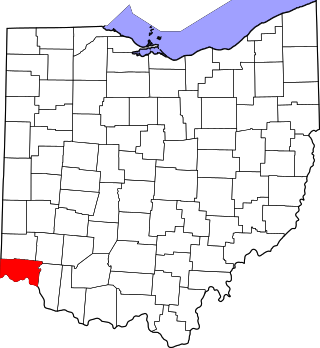
This is a list of the National Register of Historic Places listings in Hamilton County, Ohio.

The A.M. Detmer House is a historic residence in Cincinnati, Ohio, United States. Constructed in the 1880s, it has been named a historic site as an example of the work of a prominent architect.
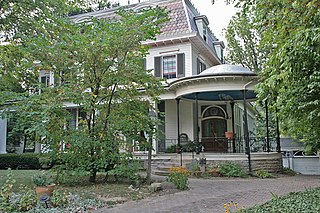
The William Resor House is a historic residence on Greendale Avenue in Cincinnati, Ohio, United States. Built in 1843, this three-story building is distinguished by architectural elements such as a mansard roof, third-story dormer windows, and a large wrap-around verandah porch. The front of the house is a simple square, but its facade is broken up by the roofline of the porch, which includes a gazebo with a dome and cast iron decorations. These elements are newer than the rest of the house, having been added in the 1890s at the same time as a relocation, at which time the house was turned to face Greendale Avenue. When built, the house was a simple box in the Greek Revival style, and it assumed its present Second Empire appearance only after an intermediate period in which the style was a generic Victorian. The previous occupant of the site had been a summer cottage.

The James D. Conrey House is a historic house located on an old intercity road in southeastern Butler County, Ohio, United States. Although the identification is unclear, it may have once been a tavern on the road, which connects Cincinnati and Columbus. A well-preserved piece of the road's built environment, it has been designated a historic site.
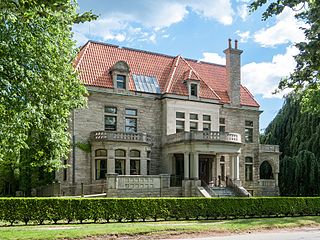
The Bellevue Avenue Historic District is located along and around Bellevue Avenue in Newport, Rhode Island, United States. Its property is almost exclusively residential, including many of the Gilded Age mansions built as summer retreats around the turn of the 20th century by the extremely wealthy, including the Vanderbilt and Astor families. Many of the homes represent pioneering work in the architectural styles of the time by major American architects.
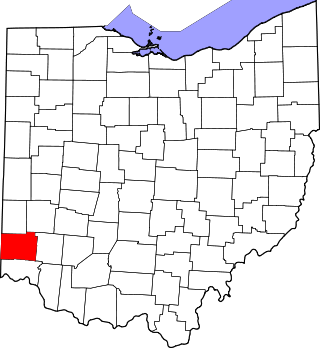
This is a list of the National Register of Historic Places listings in Butler County, Ohio.

This is a list of the National Register of Historic Places listings in Warren County, Ohio.
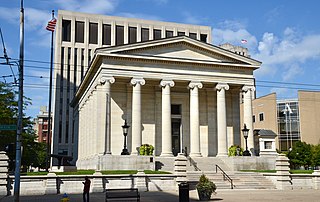
The Montgomery County Courthouse (MCC), built in 1847, is a historic Greek Revival building located in Dayton, Ohio. It is referred to locally as the Old Courthouse. The limestone building, modeled on the 5th century BC Temple of Hephaestus in Athens, Greece, is the nation's best surviving example of a Greek Revival-style courthouse.

Acorn Hall is an 1853 Victorian Italianate mansion located at 68 Morris Avenue in Morristown, Morris County, New Jersey. It was added to the National Register of Historic Places on April 3, 1973, for its significance in architecture. It serves as the headquarters of the Morris County Historical Society, which operates Acorn Hall as a historic house museum.

The Mohrman-Jack-Evans House is an historic building located at 342 Columbus Avenue in Lebanon, Warren County, Ohio. Built in 1850 in the Greek Revival and Italianate styles of architecture, it was originally a single-family house. On October 10, 1984, when it was added to the National Register of Historic Places, it was serving as the meeting place of First Church of Christ, Scientist. Today, it is the office of an insurance agency. First Church of Christ, Scientist, Lebanon is now Christian Science Society and meets at 109 West Mulberry Street in Lebanon.

The Perkins Stone Mansion is a historic house museum in Akron, Ohio, United States.

The South Fountain Avenue Historic District is a residential neighborhood in Springfield, Ohio, United States. This historic district is listed in the National Register of Historic Places.

Floraville is one of four historic districts in Lebanon, Ohio listed in the National Register of Historic Places. It is roughly bounded by Keever St. to the west, Cincinnati Ave. to the north, East St. to the east, and Orchard Ave. to the south. Comprising 440 acres, the district includes 61 buildings and 1 structure. It was listed on the National Register of Historic Places on October 10, 1984

The Alfred Kelley mansion was a historic house in Downtown Columbus, Ohio. It was the home of Alfred Kelley, built in 1838. The house stayed in the family for decades, and was later an Ohio governor's mansion, and further on, a Catholic school. It was abandoned in the 1950s, and was deconstructed in 1961 in order to build the Christopher Inn. A preservation committee tried to move and rebuild the house; after years and several moves, the stone remnants were placed at the Hale Farm and Village near Akron in 1973, where they remain today.






















